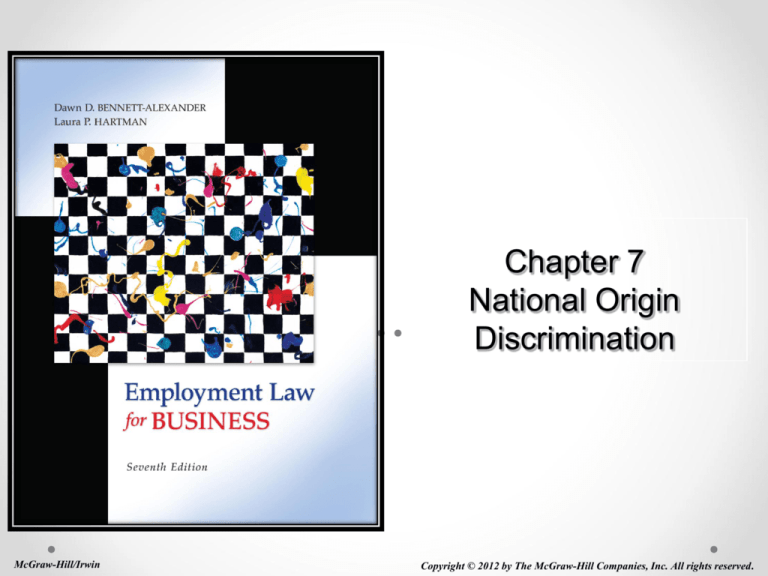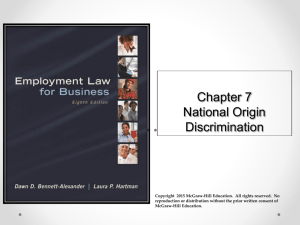
Chapter 7
National Origin
Discrimination
McGraw-Hill/Irwin
Copyright © 2012 by The McGraw-Hill Companies, Inc. All rights reserved.
Learning Objectives
Describe the impact and implications of the
changing demographics within America on the
American workforce
Define the prima facie case for national origin
discrimination under Title VII
Explain the legal status surrounding “Englishonly policies” in the workplace
7-2
Learning Objectives
Describe a claim for harassment based on
national origin and discuss how it might be
different from one based on other protected
classes
Identify the difference between citizenship and
national origin
Explain the extent of protection under the
Immigration Reform and Control Act
7-3
Introduction
The U.S. is a melting pot of different cultures
Traditional distinctions in the law between race
and national origin are becoming blurred
A decision based on either race or national
origin is illegal
7-4
Legislation Prohibiting National Origin
Discrimination
Title VII, Civil Rights Act of 1964
Sec. 703(a)
Immigration Reform and Control Act of 1986
Sec. 274A(a)
Sec. 274(B)(a)
7-5
Realities about National Origin
Discrimination
“Citizenship” and “national origin” are not
synonymous
All business establishments (e.g. restaurants)
must abide by Title VII non-discrimination
principles during hiring
It is illegal discrimination for an employer to
require that employees speak only English at
work
7-6
The Changing Workforce
In 2009, foreign-born workers represented more
than 15.5 percent of U.S. workers
The median weekly earnings of foreign-born fulltime workers was significantly less than for nonforeign-born workers
7-7
The Changing Workforce
By 2018, the U.S. workforce is expected to be
comprised of
17.6 percent Hispanics
12.1 percent African-Americans
5.6 percent Asians
Complaints based on alleged national origin
discrimination on the rise since 1999
Represents the fastest-growing source of complaints
7-8
Regulatory Overview
National origin discrimination protection
offered by Title VII: It is unlawful for an
employer to limit, segregate, or classify
employees
In any way on the basis of national origin that would
deprive them of the privileges, benefits, or
opportunities of employment
7-9
Regulatory Overview
An employee may claim discrimination on the
basis of national origin if
He or she is a member of a protected class
He or she was qualified for the position for which he
or she applied or in which he or she was employed
The employer made an employment decision against
this employee or applicant.
The position was filled by someone who was not a
member of the protected class
7-10
Member of the Protected Class
Based only on country of origin, not on country
of citizenship
No protection based on status as aliens
National origin encompasses:
Employee’s place of birth
Ethnic characteristics or origins
Physical, linguistic, or cultural traits closely associated
with a national origin group
7-11
Qualification/BFOQs
Claimant must show that he or she meets the
job’s requirements
No accommodation of one’s national origin is
required of employers
An employer may set forth why a specific
national origin is a legitimate job requirement
(bona fide occupational qualification)
7-12
English Fluency and Speaking Native
Languages in the Workplace
“English-only” policies have become increasingly
relevant
Employers should not permit managers to
arbitrarily impose language restrictions
7-13
English Fluency and Speaking Native
Languages in the Workplace
To be protected the employer must show
English fluency is required for the job
The requirement is necessary to maintain supervisory
control of the workplace
English-only rules
7-14
Adverse Employment Action and
Dissimilar Treatment
Adverse employment action: Any action or
omission that takes away a benefit, opportunity,
or privilege of employment from an employee
It includes
Demotion
Termination
Removal of privileges afforded to other employees
7-15
Adverse Employment Action and
Dissimilar Treatment
Adverse effect may arise from
Disparate treatment
Disparate impact
7-16
Harassment on the Basis of National
Origin
Claims have been on a sharp increase
Not all harassment is prohibited
Must be severe or pervasive
Common concerns include
Ethnic slurs
Workplace graffiti
Other offenses based on employee traits
7-17
Guidelines on Discrimination Because
of Religion or National Origin
Applies to federal agencies or employers who
enter into contracts with a government agency
Individuals must be hired and retained without
regard to their religion or national origin
The guidelines impose on the federal contractor
an affirmative obligation to prevent
discrimination
7-18
Guidelines on Discrimination Because
of Religion or National Origin
Provisions include the following ethnic groups
Eastern, Middle, and Southern European ancestry,
including Jews, Catholics, Greeks, and Slavs
Excluded because of coverage elsewhere
Blacks
Spanish-surnamed Americans
Asians
Native Americans
7-19
Middle Eastern Discrimination After
September 11, 2001
“Code Z”
Key discrimination issues
Different treatment due to attire
Ethnic harassment, particularly in relation to security
concerns
More stringent security checks or other
preemployment requirements
Effective resolution – Sensitivity to employee’s
concerns
7-20
Citizenship and the Immigration Reform
Control Act
Legal aliens are often restricted from access to
certain government or other positions by statute
“Political function” exception
Immigration Reform and Control Act
7-21
Citizenship and the Immigration Reform
Control Act
Difference between Title VII and IRCA
Title VII – does not require proof of discriminatory
intent
IRCA – requires that the adverse action be knowingly
and intentionally discriminatory
Innocent or negligent discrimination is a
complete defense to a claim of discrimination
under IRCA
7-22
Undocumented Workers
IRCA makes it unlawful for employers to hire,
recruit, or refer for a fee to unauthorized workers
Employers are required to verify all newly hired
employees
Form I-9
“No-match” rule implemented in 2007
Supplemental Proposed Rule in March 2008
Supplemental Final Rule in October 2008
7-23
Undocumented Workers
Obama administration
Rescinded “no-match” rule in 2009
Focused on civil and criminal actions against
employers that knowingly hired undocumented
workers
Immigration and Customs Enforcement (ICE)
IRCA
Employers subjected to random compliance
inspection under the General Administrative Plan
7-24
Undocumented Workers
EEOC
Workers’ undocumented status does not justify
workplace discrimination
Employers may be liable for monetary remedies
Hoffman Plastic Compounds Inc. v. NLRB
Fair Labor Standards Act
Protects unauthorized workers from abuse
7-25
Alternate Basis for National Origin or
Citizenship Discrimination
Identifiable classes of persons who are
subjected to intentional discrimination solely
because of their ancestry or ethnic
characteristics
Section 1981 – discrimination because of what
they are
St. Francis College v. Al-Khazraji
7-26
Management Tips
In case of BFOQs ensure that only persons of
that origin are selected
Employees can file national origin discrimination
claims even if they have been simply perceived
to be of a particular origin
Customer, client, or co-worker preference,
comfort, or discomfort cannot be stated as the
source of BFOQ.
7-27
Management Tips
Federal contractors must follow the Guidelines
on Discrimination Because of Religion or
National Origin
Before instituting a policy, consider the
implications of both Title VII and IRCA
Recognize the concerns of Middle Eastern
employees in the post-September 11 era
7-28






